Bringing a product to market is no longer about packing in features and hoping for the best. Teams nowadays concentrate on creating lean, testable versions, or Minimum Viable Products (MVPs), which enable quicker releases, support continuous improvement, and validate user needs early.
Moreover, as product development cycles shrink and competition intensifies, MVPs offer a powerful way to reduce risk and improve outcomes. According to CB Insights, 35% of startups fail because there’s no market need for their product, an issue MVPs are specifically designed to prevent. When implemented correctly, an MVP acts as a learning tool, not just a launchpad.
So, what exactly makes a product “viable” and “minimal” at the same time?
Also, how does this approach align with Agile, Lean Startup, MVP, or iterative development models?
These are critical questions for founders, product managers, and developers alike. As we move ahead, we’ll break down each layer of this concept in a practical, actionable way.
In this blog, we will explore the definition, process, frameworks, benefits, and post-launch strategies around building a successful Minimum Viable Product.
First, we have to understand what an MVP is and what the term stands for in modern software and business contexts.
What is Minimum Viable Product (MVP)?
MVP stands for Minimum Viable Product, where:
- “Minimum” refers to building only the core functionalities required to solve the user’s primary problem.
- “Viable” indicates that the product must still be functional, usable, and valuable.
- “Product” implies something ready to be tested in a real environment.
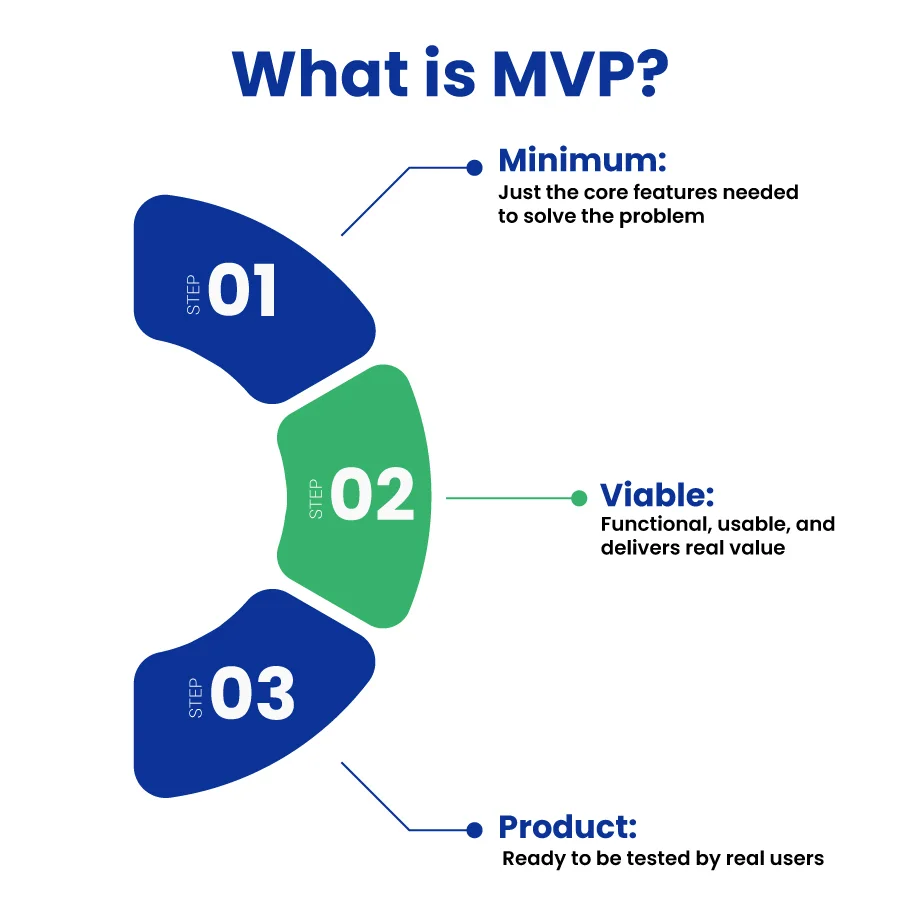
Table of Contents
Furthermore, this acronym is widely adopted in Agile, Lean Startup, and iterative development environments. In essence, an MVP is a strategy used to test business ideas efficiently without wasting time or resources.
At its core, a Minimum Viable Product is the simplest version of a product that delivers value to early adopters. It contains just enough features to solve a specific problem and allows the team to collect real user feedback. Moreover, an MVP development approach enables faster market entry and cost-effective learning.
As we are discussing the concept here, it’s important to note that the goal is not to launch something incomplete. Instead, the focus is on validating assumptions and refining the product direction. By doing so, teams avoid overengineering and instead build what users need.
Still Figuring Out How To Launch The Right Product? Start with a minimum viable product that aligns with your market and business goals.
How Does MVP Fit into the Product Development Process?
Knowing how an MVP fits into the larger development lifecycle is essential to maximizing its potential. Furthermore, knowing where MVP fits allows product teams to align efforts, reduce time-to-market, and increase the chances of launching a product that solves a real problem.
Now, we’ll explore how MVP works within the product lifecycle.
The MVP stage typically occurs after ideation and before full-scale development. Once a product idea is validated internally, the MVP acts as a real-world test to validate assumptions externally with real users.
Furthermore, the MVP phase helps teams decide what to do to pivot, persevere, or abandon the idea altogether.
For instance, product life cycles traditionally move from concept → MVP → beta testing → full launch → continuous improvement.
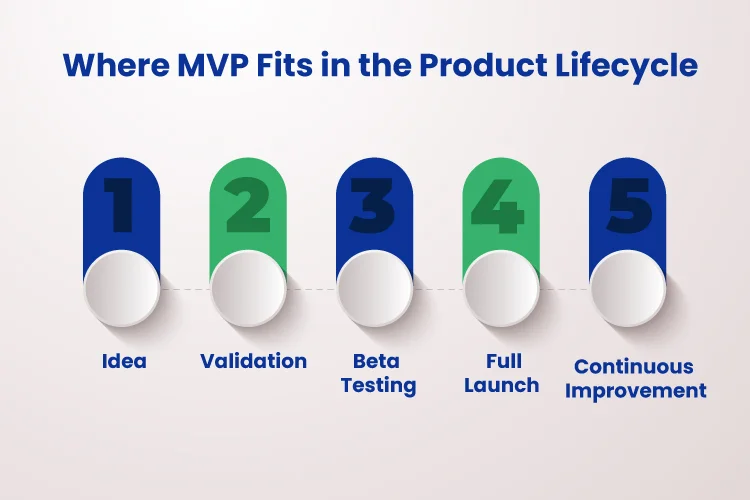
During the MVP phase, the focus is on learning, not scaling. Teams aim to observe user behavior, identify friction points, and refine the roadmap before investing in expensive features.
Moreover, according to Harvard Business Review, launching with an MVP can reduce development time by up to 50%, a compelling reason why modern companies embrace this lean approach early in the product lifecycle.
What are the Steps to Build a Minimum Viable Product?
Successfully building an MVP is about solving a real problem for a defined user group, with a laser focus on feedback and iteration. Moreover, the process must follow a clear roadmap to avoid scope creep and ensure market alignment.
Below, we’ll walk through the 5 key steps you need to follow to build a successful MVP that delivers both learning and value.
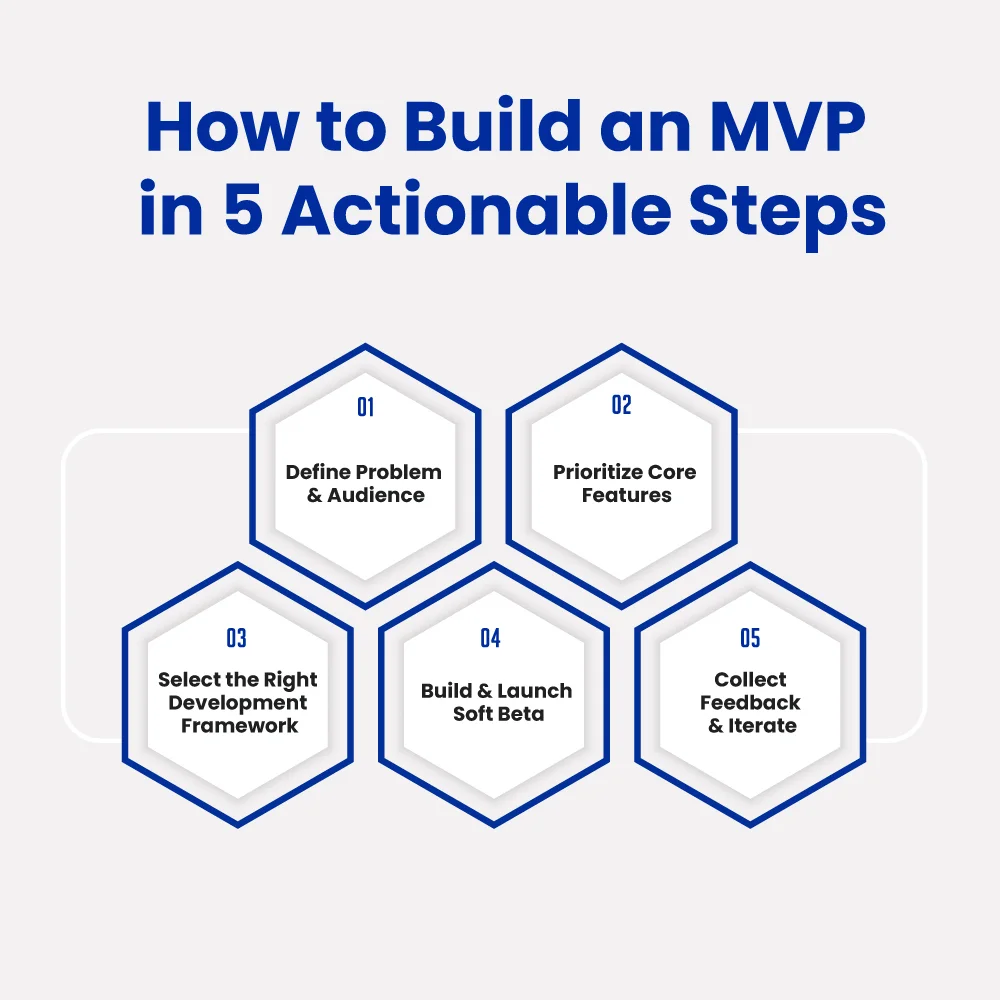
Step 1: Defining the Problem and Target Users
Before writing a single line of code, teams must begin by clearly defining the problem they are solving. Furthermore, understanding who experiences this problem and how severely they feel its impact is fundamental to building the right solution.
Here’s what needs to happen in this step:
- Conduct user research to identify pain points.
- Segment your audience and prioritize your ideal customer profile (ICP).
- Frame the problem statement: What issue are you solving, and why does it matter?
Additionally, validating that the problem is real and worth solving saves significant time downstream. As we are discussing early validation here, consider using surveys, interviews, or competitor analysis to uncover unmet needs and product gaps.
Step 2: Identifying Core Features
Once the problem is clear, the next step is identifying only the features necessary to solve it. This is where many teams go wrong by trying to include too much. Instead, focus on building just enough to deliver meaningful value to your target users.
To make this easier, consider breaking features down using the MoSCoW method:
- Must-have: Essential for MVP success
- Should-have: Important but not urgent
- Could-have: Nice-to-have for later versions
- Won’t have (for now): Not needed in the MVP
Moreover, always prioritize user impact over internal preferences. As we identified the problem earlier, now we’re narrowing the solution to its core. Keeping it lean, focused, and user-centric.
Step 3: Choosing the Popular MVP Development Framework
Selecting the right MVP framework sets the tone for how quickly and effectively you can validate your product idea. While the “minimum” and “viable” parts remain consistent, the structure you use to build and iterate depends on your business goals, technical expertise, and timeline.
Below are some of the most widely adopted MVP frameworks and what makes them effective:
1. Lean Startup MVP
Popularized by Eric Ries, this approach follows a Build → Measure → Learn loop. The goal is to create a fast, testable version of your product, measure user behavior, and learn what to improve or remove. It’s ideal for early-stage startups looking to minimize waste and accelerate learning.
2. Agile MVP Development
Agile focuses on iterative development and continuous delivery. In this framework, MVP is developed in sprints, with each sprint delivering a working increment that brings the team closer to product-market fit. Agile is particularly helpful for teams that prefer flexibility and fast feedback cycles.
3. Design Thinking
Design Thinking begins with deep empathy for users. It follows a five-step loop: Empathize → Define → Ideate → Prototype → Test. The MVP here is shaped through creative problem-solving and frequent validation, making it useful for teams prioritizing UX and innovation
4. No-Code/Low-Code MVP
For non-technical founders or teams aiming to validate ideas quickly, no-code and low-code platforms offer drag-and-drop interfaces to build functional MVPs without full development teams. Tools like Bubble, Webflow, or Glide are often used to test hypotheses with real users at minimal cost.
5. Wizard of Oz MVP
In this model, users believe they are interacting with a fully automated product, but the backend is handled manually. This is perfect for validating demand and user interaction before investing in automation or complex infrastructure.
Step 4: Building, Testing, and Launching
With features finalized and the framework selected, it’s time to start building. However, building an MVP doesn’t mean rushing to launch; it involves careful execution, testing, and refining before users get access.
Here’s what this phase typically includes:
- Develop the core functionality first, nothing extra.
- Run internal QA testing to fix critical bugs.
- Perform usability tests with a small group of users.
- Prepare for a soft launch with limited access (beta testing).
Moreover, the MVP should be stable, usable, and reliable enough to reflect your product vision even if it’s not feature-complete.
Step 5: Gathering Feedback and Iterating
This is where the true value of MVP begins to show. Once users interact with the product, you’ll gather real feedback that will guide your next set of decisions. Furthermore, collecting data early allows teams to make adjustments before scaling.
To maximize learning:
- Use analytics tools to track engagement and drop-off points.
- Conduct user interviews or surveys to understand satisfaction and pain points.
- Organize the feedback into actionable categories like bugs, usability, and feature requests.
Additionally, iteration should be continuous. Every feedback loop is an opportunity to refine your product and move closer to product-market fit.
MVP vs. Other Product Development Approaches
Choosing the right development strategy can make or break a product’s success. While the MVP model focuses on delivering value with minimum effort, several other approaches follow different philosophies.
In this section, we will discuss how MVP compares to 4 widely used product development methods and highlight where it stands out.
1. MVP vs. Traditional Product Development
Traditional development focuses on building a complete, feature-rich product before releasing it to the market. This approach involves significant time and resource investments upfront.
Furthermore, it assumes the team knows exactly what users want, which often leads to misaligned products and wasted efforts.
In contrast, the MVP approach avoids these risks by starting small. It allows teams to validate core assumptions early, saving both time and cost. Rather than betting everything on a full launch, MVP enables smarter decisions based on real user data.
2. MVP vs. Prototype Development
A prototype is usually a non-functional or partially functional model created to test concepts, UI/UX design, or specific interactions. It is commonly used for internal validation or stakeholder feedback.
However, it doesn’t offer insights from real-world usage because it’s not designed for actual deployment.
On the other hand, an MVP is a functional product delivered to real users. As we’re discussing the difference here, it’s clear that MVPs generate more actionable feedback and validate product-market fit.
If you’re in the early stages of shaping your idea visually and experientially, investing in a strong product design process lays the foundation for both effective prototypes and successful MVPs.
3. MVP vs. Proof of Concept (PoC)
A Proof of Concept is typically used to test technical feasibility. It answers the question:
Can we build this? But it does not explore the way it should be built from a customer or business perspective.
Meanwhile, MVPs address both technical execution and market validation. Additionally, while PoCs are limited to internal teams, MVPs go into users’ hands, allowing you to measure real engagement, feature relevance, and usability.
4. MVP vs. Minimum Lovable Product (MLP)
The Minimum Lovable Product concept takes MVP one step further by focusing on user delight instead of just usability. An MLP must solve the core problem and create an emotional connection with users. While both models aim for fast validation, MLP focuses on early adoption through an exceptional user experience.
Moreover, MVPs can sometimes feel raw or basic. That’s where MLPs step in, especially in saturated markets where differentiation depends on user satisfaction, not just functionality.
As we’ve discussed these comparisons, it’s clear that MVP stands out for its ability to deliver real-world validation, minimize risk, and support lean product thinking.
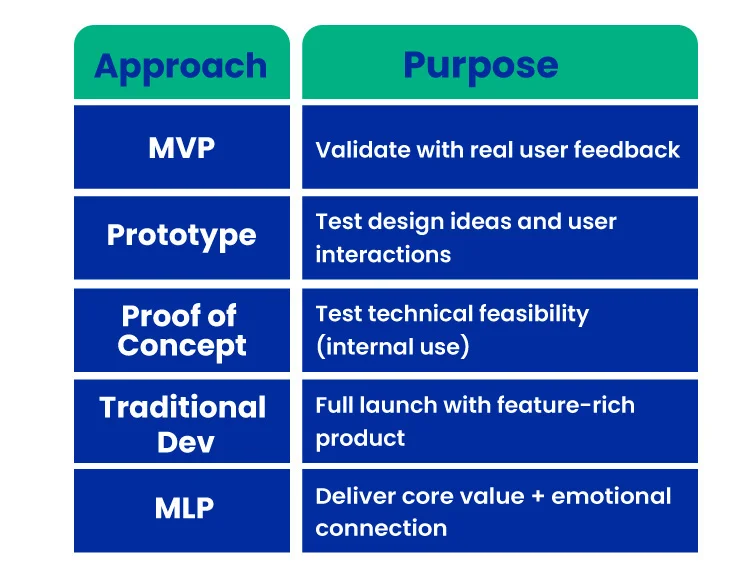
Below, we’ll examine the core traits of a high-quality MVP and highlight common mistakes that teams should actively avoid.
What are the Most Common Characteristics of a Successful MVP?
MVP benefits must balance simplicity and functionality, as we’re talking about success indicators here. It should create enough value for users to test the concept, not overwhelm them with unnecessary features.
Here are the essential MVP characteristics:
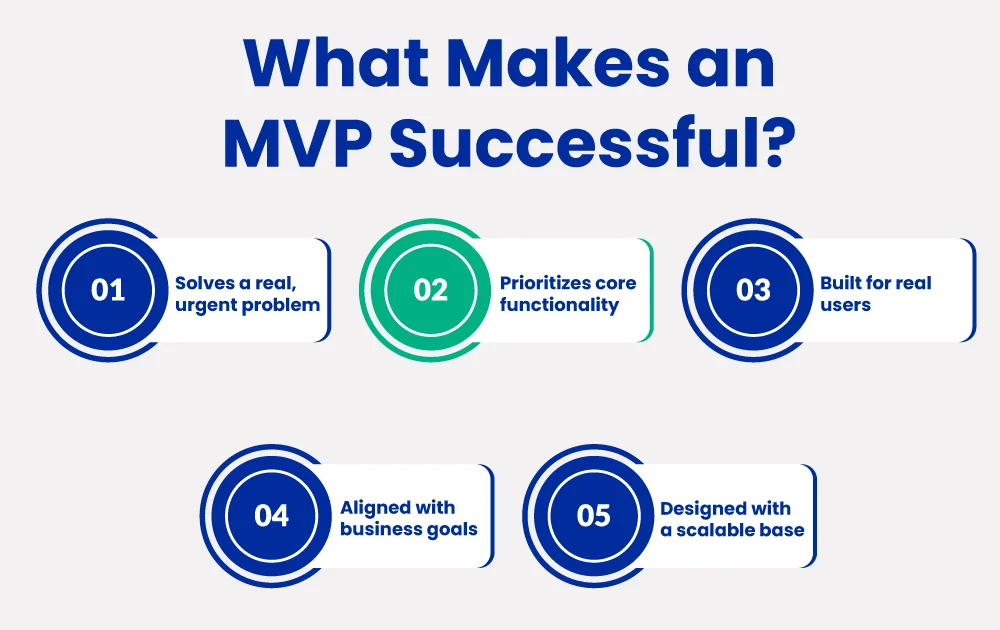
1. Solves a Real Problem
The MVP should directly address a clearly defined pain point. Moreover, the solution must feel urgent or valuable to your target audience; otherwise, feedback will be unreliable.
2. Focused on Core Functionality
Rather than building for everyone, a strong MVP focuses on doing one thing exceptionally well. This sharpens the user experience and accelerates learning.
3. User-Tested and Feedback-Oriented
It must be tested by real users and generate actionable feedback. Additionally, usability and relevance take priority over visual perfection or advanced capabilities.
4. Aligned with Business Goals
A good MVP contributes to your broader strategy, regardless of validating market demand, testing monetization models, or reducing technical uncertainty.
5. Scalable Foundation<
While minimal, the MVP should be designed in a way that allows easy expansion. As we discussed earlier, this helps the team move smoothly into future iterations.
In short, a great MVP delivers measurable value, generates user insights, and lays the groundwork for growth without burning time or budget.
Which Common Mistakes to Avoid While Developing an MVP?
While MVPs are designed to simplify development, they can still go wrong if not executed carefully. We will highlight the frequent errors that reduce effectiveness and compromise MVP product design below.
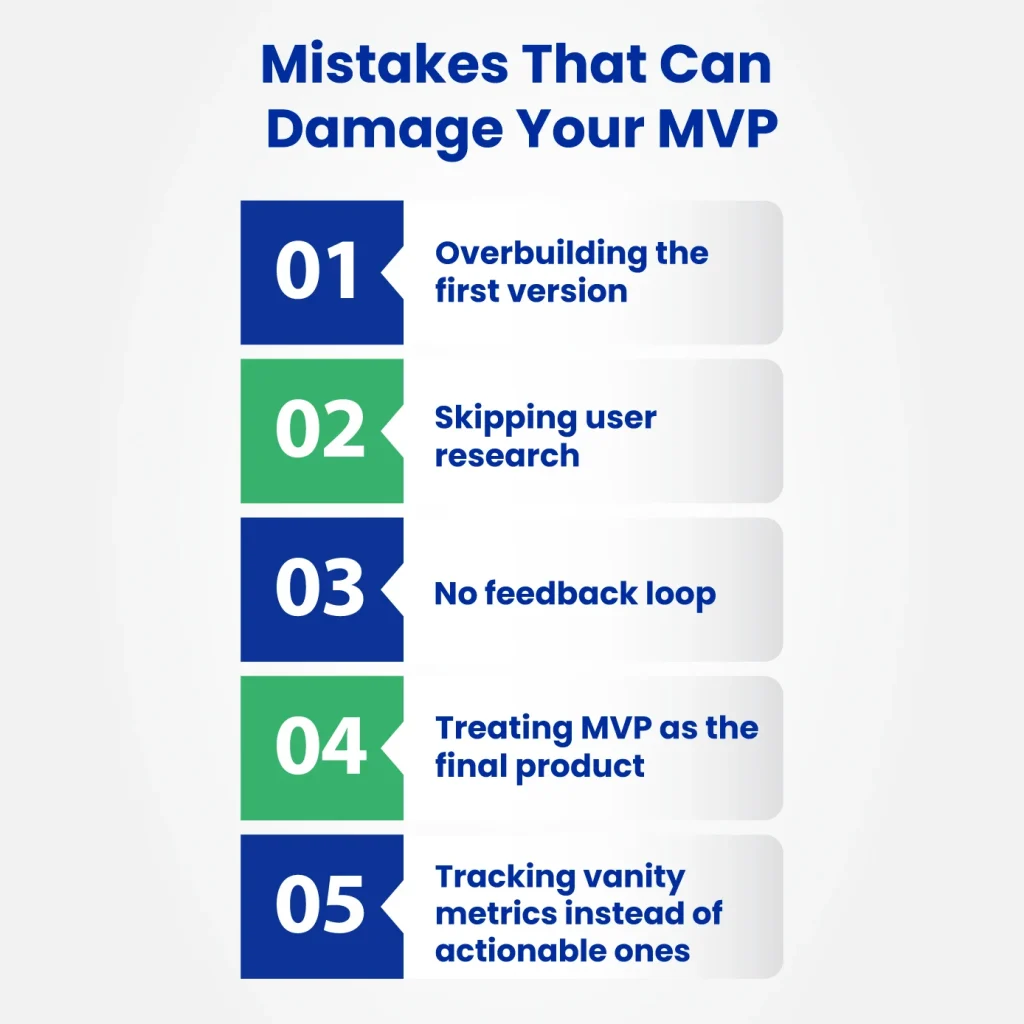
Overbuilding the First Version
Many teams try to squeeze in too many features, turning the MVP into a near-final product. This not only delays launch but also clouds user feedback. Furthermore, it defeats the purpose of rapid learning.
Ignoring Target Users
Building without clearly understanding the audience often leads to misaligned features. As we mentioned in earlier sections, defining your users upfront is critical to delivering relevance.
Skipping Validation
Launching without any feedback mechanism, such as analytics, surveys, or interviews, leaves you guessing. An MVP must validate assumptions, not just exist in the market.
Treating MVP as the Final Product
A common trap is stopping development after the MVP launch. However, the MVP is just the beginning. Teams must use feedback to iterate and evolve the product continuously.
Choosing the Wrong Metrics
Focusing on vanity metrics like downloads instead of engagement, retention, or feedback can misguide decisions. Moreover, success should be tied to learning goals, not superficial performance.
As we discussed the key characteristics above, these mistakes serve as cautionary signs. Avoiding them ensures your MVP fulfills its role as a learning engine, not a rushed product.
Frequently Asked Questions (FAQs)
2. How to Build a Minimum Viable Product?
To build a minimum viable product, follow these key steps:
- Identify the core problem and target audience.
- Prioritize must-have features.
- Choose a suitable development framework (e.g., Agile, Lean Startup).
- Build a functional version with minimal complexity.
- Launch, gather feedback, and iterate based on real user data.
3. What Does MVP Stand for in Product Development?
MVP stands for Minimum Viable Product, a strategy used in product development to launch a simplified version of a product with just enough features to satisfy early users.
4. What is an MVP in Software Development?
In software development, an MVP is a functional prototype or initial version of a digital product that includes only core features. It’s designed to be released quickly to test user interest, reduce time-to-market, and gather actionable feedback for future iterations.
5. What is a Minimum Viable Product in Agile?
In Agile development, an MVP is a working version of a product built in sprints, focused on continuous delivery and early feedback. It allows teams to release quickly, validate functionality, and adapt features based on iterative testing and user needs.
Key Takeaway
The goal of developing a Minimum Viable Product (MVP) is to launch with purpose rather than just quickly. MVP enables teams to validate assumptions early, minimize development waste, and stay laser-focused on solving real user problems.
What makes an MVP truly effective in the long run is its ability to bring clarity to your product vision. By focusing on core functionality and iterating based on user feedback, you create not just a testable version but a scalable foundation for growth.
As part of a broader product development strategy, an MVP bridges ideas and execution without losing direction. Ultimately, your MVP should reflect both what users need today and how your product can evolve tomorrow.
Still Wondering How To Turn Feedback Into Real Traction? Keep the user at the center, adapt often, and build with vision; your MVP deserves a strategy that works.
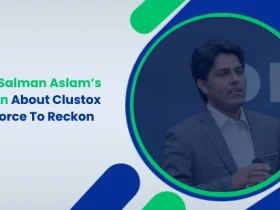
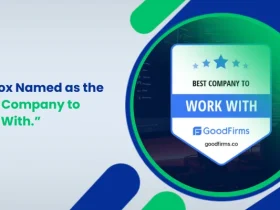
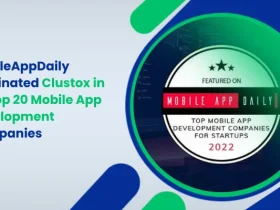
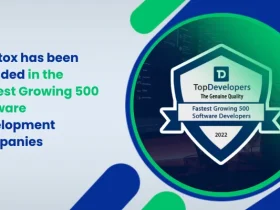
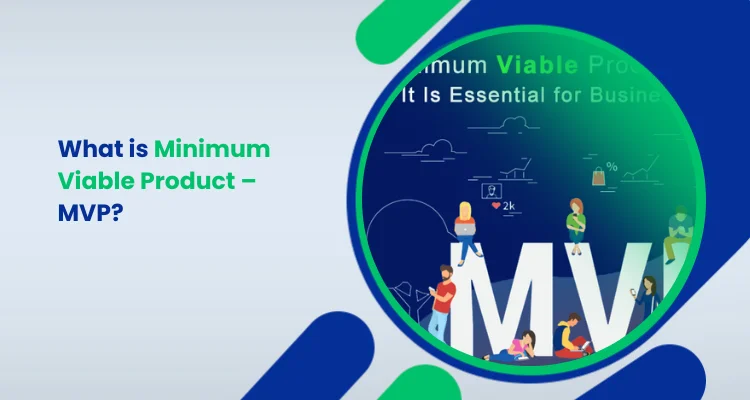
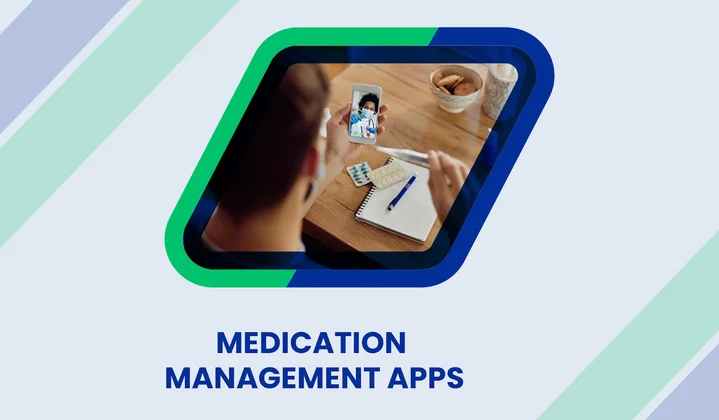
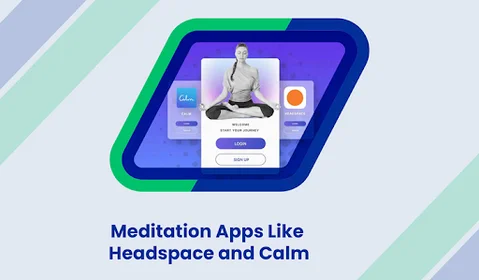
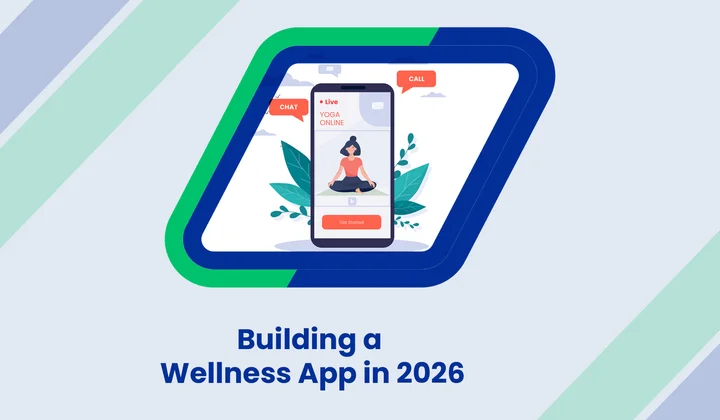
This blog does such a great job of breaking down MVP in a way that feels both practical and inspiring. I really like how it balances strategy with real-world execution, it’s the kind of guide that makes product development feel less overwhelming and more purposeful.